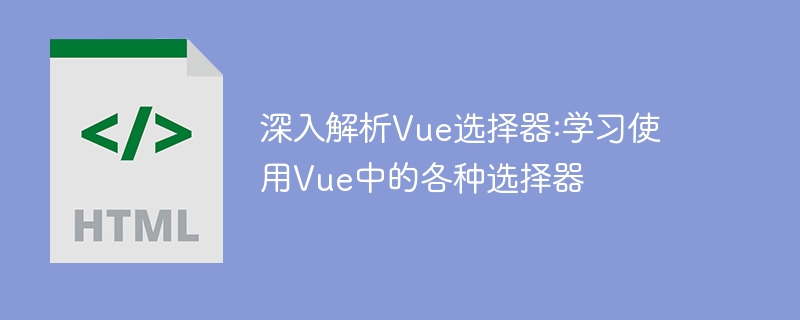Home >Web Front-end >HTML Tutorial >In-depth study of Vue selectors: Master the use of various selectors in Vue
In-depth study of Vue selectors: Master the use of various selectors in Vue
- 王林Original
- 2024-01-13 13:52:061733browse

In-depth analysis of Vue selectors: Learn to use various selectors in Vue
Vue.js is a popular JavaScript framework that is widely used in building user interface. In Vue, selectors are our commonly used tools, which can help us find specific elements and operate on them. This article will provide an in-depth analysis of Vue selectors and help readers learn to use various selectors in Vue.
- ID Selector
The ID selector selects elements through their id attribute. In Vue, we can select the element by adding the id attribute in the template.
<template> <div id="myDiv">Hello World</div> </template>
Use the ID selector to select elements:
<script>
let element = document.querySelector("#myDiv");
console.log(element.innerText); // 输出:Hello World
</script>- Class selector
The class selector selects elements by their class name. In Vue, we can select the element by adding the class attribute to the template.
<template> <div class="myClass">Hello World</div> </template>
Use the class selector to select elements:
<script>
let elements = document.querySelectorAll(".myClass");
for(let i = 0; i < elements.length; i++) {
console.log(elements[i].innerText); // 输出:Hello World
}
</script>- Element selector
The element selector selects elements by their tag names. In Vue, we can directly use the tag name to select elements.
<template> <div>Hello World</div> </template>
Use the element selector to select elements:
<script>
let elements = document.querySelectorAll("div");
for(let i = 0; i < elements.length; i++) {
console.log(elements[i].innerText); // 输出:Hello World
}
</script>- Attribute selector
The attribute selector selects elements through an attribute of the element. In Vue, we can select elements by adding attribute selectors in the template.
<template> <div data-test="myDiv">Hello World</div> </template>
Use attribute selectors to select elements:
<script>
let elements = document.querySelectorAll('[data-test="myDiv"]');
for(let i = 0; i < elements.length; i++) {
console.log(elements[i].innerText); // 输出:Hello World
}
</script>- Descendant selectors
Descendant selectors select elements through their descendant relationships. In Vue, we can use spaces to represent descendant relationships.
<template>
<div>
<div>
<span>Hello World</span>
</div>
</div>
</template>Use the descendant selector to select elements:
<script>
let elements = document.querySelectorAll("div span");
for(let i = 0; i < elements.length; i++) {
console.log(elements[i].innerText); // 输出:Hello World
}
</script>- Direct child element selector
The direct child element selector selects through the parent-child relationship of the element element. In Vue, we can use ">" to express the parent-child relationship.
<template>
<div>
<div>
<span>Hello World</span>
</div>
</div>
</template>Use direct child element selectors to select elements:
<script>
let elements = document.querySelectorAll("div > span");
for(let i = 0; i < elements.length; i++) {
console.log(elements[i].innerText); // 输出:Hello World
}
</script>The above are commonly used selectors in Vue. They can help us select elements conveniently and operate on them. By learning and mastering the use of these selectors, we can better write Vue applications and improve development efficiency.
To summarize, this article provides an in-depth analysis of Vue selectors and provides specific code examples. I hope that through studying this article, readers can master the use of Vue selectors and better apply the Vue framework for development.
The above is the detailed content of In-depth study of Vue selectors: Master the use of various selectors in Vue. For more information, please follow other related articles on the PHP Chinese website!

